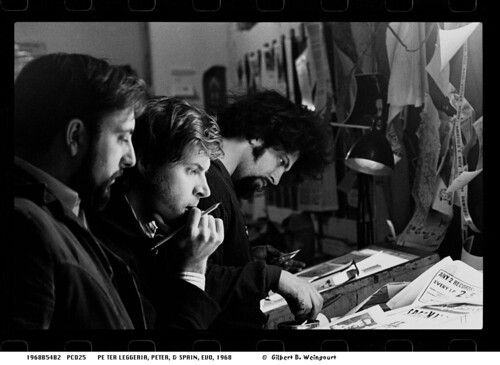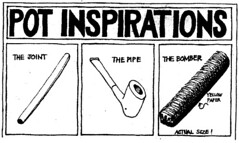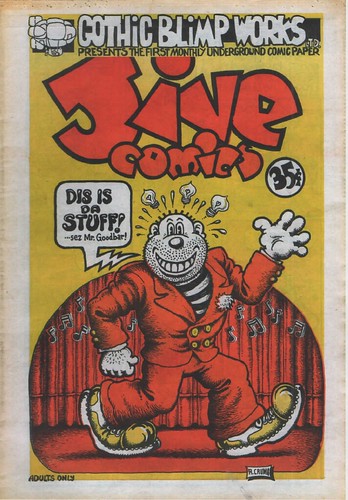Earlier this week, the Arthur L. Carter Journalism Institute launched “Blowing Minds: The East Village Other, the Rise of Underground Comix and the Alternative Press, 1965-72,” with a rousing discussion that’s now archived on the exhibit’s Website, along with new audio interviews with veterans of the Other. Over the course of seven weekend editions of The Local, we’ve heard from all but one of the EVO alumni who spoke on Tuesday’s panel. Here now, to cap off our special series, is the story of Peter Leggieri.
 Gil Weingourt Left to right: Peter Leggieri, Peter Mikalajunas, and Spain Rodriguez.
Gil Weingourt Left to right: Peter Leggieri, Peter Mikalajunas, and Spain Rodriguez.From the first day that I began working at The East Village Other, I was overcome by the sense that it was not only a newspaper but a strange and magical ship on a voyage with destiny. It seemed as though each issue printed was a new port of call, and the trip from one issue to the next, a new adventure. Many of EVO’s crew members expressed that same weird feeling – a sense of excitement and creative power.
And what a crew that was! No one was recruited. I don’t recall a resume ever being submitted. They all simply showed up and started working. EVO’s crew might just have been the greatest walk-on, pick-up team in the history of journalism. She was The Other but her staff of artists, poets, writers, photographers and musicians affectionately called her EVO. Her masthead bore a Mona Lisa eye. EVO created a cultural revolution and won the hearts and minds of a generation. She was the fastest ship in the Gutenberg Galaxy.
In the Beginning
I was the anonymous Other, the one editor-owner unknown to the public. I did not party. I did not schmooze with the literati or seek publicity. I had no time for such things. I worked seven days a week, 20 hours a day and, because of law school, I had to be sober. My friend, the poet John Godfrey, told me that I was afflicted with a Zen curse: a hermit condemned to be surrounded by people and events. That was certainly the case for me in the 1960s. Read more…
 A.J. Weberman, Yossarian, Vincent Titus
A.J. Weberman, Yossarian, Vincent TitusHow One-Legged Terry became a member of A.J. Weberman’s circle fades into the mists of memory. Surely, he fit the mold of a Weberman associate with his good humor and dominant, eccentric personality. I met Terry along with a number of people A.J. had acquired from a series of “Dylanology” lectures he had given at Manhattan’s New School for Social Research. This was during a five-month period in 1970 in which I had crossed the country with friends in a (then almost requisite) Volkswagon bus, to spend time with the underground comix community, which by then had assembled in San Francisco.
Terry went by the full moniker of Terry Noble in the United States and Terry Ephraite in Israel, where he had gone to work on a kibbutz after finishing his education. While there, he had been assigned to work atop a hopper that loaded agricultural produce into a machine for processing. His job was to assist in moving the produce from a conveyer that lifted the material to the hopper. After a few days on the job, the platform on which he was standing collapsed, dumping him into the machinery and mangling his left leg. What was left had to be amputated just above the knee. As he remembered his thoughts at the time, they were about the loss of his shoe, one of a pair he had recently bought.
When he sought compensation for his loss, it was revealed that the platform had also collapsed in the recent past, costing another Jewish-American volunteer a leg. Terry surmised that it made more sense to assign an expendable American to the dangerous positions than to fix the underlying fault. Because of the negligence involved, Terry had won a settlement of about $50,000 for his loss. Read more…
 Mar. 3, 1969 cover by Kim Deitch
Mar. 3, 1969 cover by Kim DeitchHe was a roughneck. He certainly wasn’t politically correct and his blunt management style definitely took getting used to. In fact I really didn’t know what to make of him at first. But during the time I worked at The East Village Other, I received any number of sanctimonious promises from the people I worked with that didn’t seem to amount to much. Joel Fabrikant was no sanctimonious hippie or any other kind of hippie, but he always kept his word.
I was actually drawing comics for EVO, as it was called by most of us, before Joel got there. The first time I showed up at the storefront office on Avenue A was at the start of 1967. Allen Katzman, EVO’s nominal editor, looked at the art samples I brought. He told me they were interesting, but that EVO was looking for work that was more, “psychedelic.” Psychedelic was a buzzword of the moment. Put simply it meant, “trippy,” or drug-influenced.
I didn’t have to go far to pipe directly into that. Before I even left the office, Allen Katzman introduced me to Bill Beckman, the art editor. I knew who Bill Beckman was. In fact he was one of my initial inspirations for showing up at EVO.
Back in Westchester, where I had been employed as a child care worker, perhaps nine months prior to this, I showed a co-worker some of the artwork I’d been doing in my spare time. A curious thing about this artwork was that at a certain point, it had started morphing into primitive comic strips. Read more…
 Detail from an illustration by Bill Beckman.
Detail from an illustration by Bill Beckman.I came to EVO in late 1965. I think the paper was about three issues old. Walter Bowart had quit his job as a bartender at the Dom on St. Marks Place (Ed Sanders says it was Stanley’s, maybe it was both) and had raised some money to publish what he was soon to become fond of calling “a hippie National Inquirer.” (“Hippies don’t like to read. They like pictures and big headlines.”) I had just come to New York City from Texas. At the time I wasn’t sure if I wanted to make it uptown or downtown. All that was certain was that I needed to get some kind of employment.
I was living in the basement of Bill and Debbie Beckman’s apartment on East Ninth Street between Avenues C and D. At the time, this was decidedly a sketchy neighborhood, populated by young Puerto Rican street entrepreneurs who would have duels with ripped-off car antennae, whipping each other viciously over turf or girlfriends or whatever. The old mittel Europeans, Ukrainians, and refugees who lived in the ratty tenements would scurry to get out of their way as they crossed Houston to get a knish. It would have been maybe December of 1965 when I arrived. It was shaping up as a very cold winter, with an incredible blizzard that happened just a few weeks after my arrival. Being a naive Texan, I had innocently driven my car and tried to keep it on the streets. I lost it for almost 10 days under the snow. It was all very new to me. Snow. Hippies. The East Village Other. Read more…
The Local East Village continues its celebration of the pioneering alternative newspaper of the late 1960s and early 70s, The East Village Other. This weekend, further to last week’s piece by artist Trina Robbins, we’re keeping our attention on the paper’s trailblazing illustrations, starting with an essay from Patrick Rosenkranz, the author of “Rebel Visions: The Underground Comix Revolution 1963-1975.”
 Cover of the first Gothic Blimp Works issue, by Robert Crumb
Cover of the first Gothic Blimp Works issue, by Robert CrumbI never worked for The East Village Other but I was a captivated reader from the first time I picked up an issue in 1966. As an 18-year-old naïve Catholic scholarship student at Columbia University, I was ripe for the revolution. My roommate introduced me to smoking dope that winter and my enhanced appetite often drew me to the student cafeteria, where I couldn’t help but be attracted to the radical contingent from Students for a Democratic Society sitting around their regular table. They looked to my eyes like bomb-throwing anarchists who were having wild sex every night. They often left behind copies of The East Village Other, which I picked up. It was love at first sight.
I’d never seen a publication like this before. It was full of wild accusations and bawdy language and doctored photographs. It had President Johnson’s head in a toilet bowl. It had naked Slum Goddesses, truly bizarre personal ads, and a whole different slant on the anti-war movement than my hometown paper upstate. But best of all, it had the most outrageous comic strips. The continuing saga of Captain High; the psychedelic adventures of Sunshine Girl and Zoroaster the Mad Mouse; Trashman offing the pigs and scoring babes left and right. While I enjoyed many aspects of EVO, I liked the comics the most. Read more…
It was autumn, 1966. I had come to New York from Los Angeles only months before. My then-boyfriend and I took acid and went walking through the streets of the Lower East Side – a bad idea. As the acid took hold, everything started to look weird, and not in a good way. It was a case of “people are strange when you’re a stranger,” even though the song had not come out yet. Faces came out of the rain and they looked ugly. In short, it was a bad scene, man, and we were freaked out.
And suddenly I saw that we had come to the EVO offices, in their storefront on Avenue A, across from Tompkins Square Park. Sanctuary! We rushed in and caught our breath. The office was empty except for Allen Katzman, the EVO publisher. A potbellied stove was providing warmth. I gratefully explained to Allen that the streets of the Lower East Side had become a bad trip.
As we sank into a worn sofa, Allen stood in front of the potbellied stove and talked us down. To make us feel better, he told us about the time he had been a guest speaker at a women’s college, stoned out of his mind on acid: “See, I too get unsettling experiences on acid.” Read more…










